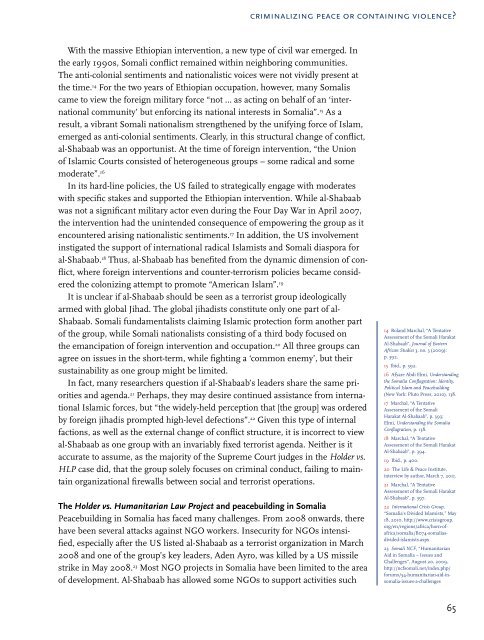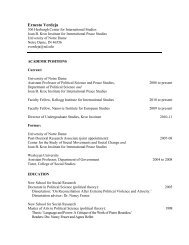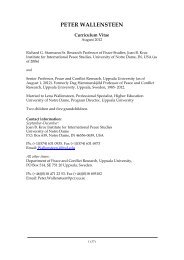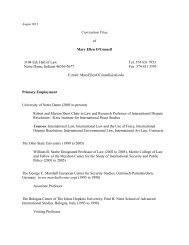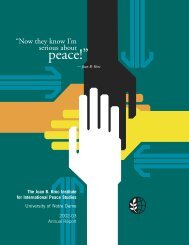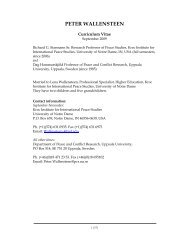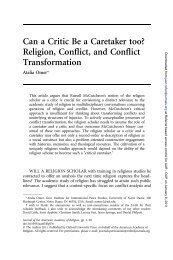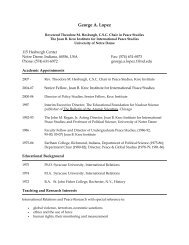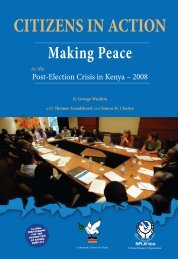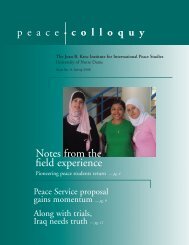Somalia: Creating Space for Fresh Approaches to Peacebuilding
Somalia: Creating Space for Fresh Approaches to Peacebuilding
Somalia: Creating Space for Fresh Approaches to Peacebuilding
Create successful ePaper yourself
Turn your PDF publications into a flip-book with our unique Google optimized e-Paper software.
criminalizing peace or containing violence?<br />
With the massive Ethiopian intervention, a new type of civil war emerged. In<br />
the early 1990s, Somali conflict remained within neighboring communities.<br />
The anti-colonial sentiments and nationalistic voices were not vividly present at<br />
the time. 14 For the two years of Ethiopian occupation, however, many Somalis<br />
came <strong>to</strong> view the <strong>for</strong>eign military <strong>for</strong>ce “not … as acting on behalf of an ‘international<br />
community’ but en<strong>for</strong>cing its national interests in <strong>Somalia</strong>”. 15 As a<br />
result, a vibrant Somali nationalism strengthened by the unifying <strong>for</strong>ce of Islam,<br />
emerged as anti-colonial sentiments. Clearly, in this structural change of conflict,<br />
al-Shabaab was an opportunist. At the time of <strong>for</strong>eign intervention, “the Union<br />
of Islamic Courts consisted of heterogeneous groups – some radical and some<br />
moderate”. 16<br />
In its hard-line policies, the US failed <strong>to</strong> strategically engage with moderates<br />
with specific stakes and supported the Ethiopian intervention. While al-Shabaab<br />
was not a significant military ac<strong>to</strong>r even during the Four Day War in April 2007,<br />
the intervention had the unintended consequence of empowering the group as it<br />
encountered arising nationalistic sentiments. 17 In addition, the US involvement<br />
instigated the support of international radical Islamists and Somali diaspora <strong>for</strong><br />
al-Shabaab. 18 Thus, al-Shabaab has benefited from the dynamic dimension of conflict,<br />
where <strong>for</strong>eign interventions and counter-terrorism policies became considered<br />
the colonizing attempt <strong>to</strong> promote “American Islam”. 19<br />
It is unclear if al-Shabaab should be seen as a terrorist group ideologically<br />
armed with global Jihad. The global jihadists constitute only one part of al-<br />
Shabaab. Somali fundamentalists claiming Islamic protection <strong>for</strong>m another part<br />
of the group, while Somali nationalists consisting of a third body focused on<br />
the emancipation of <strong>for</strong>eign intervention and occupation. 20 All three groups can<br />
agree on issues in the short-term, while fighting a ‘common enemy’, but their<br />
sustainability as one group might be limited.<br />
In fact, many researchers question if al-Shabaab’s leaders share the same priorities<br />
and agenda. 21 Perhaps, they may desire continued assistance from international<br />
Islamic <strong>for</strong>ces, but “the widely-held perception that [the group] was ordered<br />
by <strong>for</strong>eign jihadis prompted high-level defections”. 22 Given this type of internal<br />
factions, as well as the external change of conflict structure, it is incorrect <strong>to</strong> view<br />
al-Shabaab as one group with an invariably fixed terrorist agenda. Neither is it<br />
accurate <strong>to</strong> assume, as the majority of the Supreme Court judges in the Holder vs.<br />
HLP case did, that the group solely focuses on criminal conduct, failing <strong>to</strong> maintain<br />
organizational firewalls between social and terrorist operations.<br />
The Holder vs. Humanitarian Law Project and peacebuilding in <strong>Somalia</strong><br />
<strong>Peacebuilding</strong> in <strong>Somalia</strong> has faced many challenges. From 2008 onwards, there<br />
have been several attacks against NGO workers. Insecurity <strong>for</strong> NGOs intensified,<br />
especially after the US listed al-Shabaab as a terrorist organization in March<br />
2008 and one of the group’s key leaders, Aden Ayro, was killed by a US missile<br />
strike in May 2008. 23 Most NGO projects in <strong>Somalia</strong> have been limited <strong>to</strong> the area<br />
of development. Al-Shabaab has allowed some NGOs <strong>to</strong> support activities such<br />
14 Roland Marchal, “A Tentative<br />
Assessment of the Somali Harakat<br />
Al-Shabaab”, Journal of Eastern<br />
African Studies 3, no. 3 (2009):<br />
p. 392.<br />
15 Ibid., p. 392.<br />
16 Afyare Abdi Elmi, Understanding<br />
the <strong>Somalia</strong> Conflagration: Identity,<br />
Political Islam and <strong>Peacebuilding</strong><br />
(New York: Plu<strong>to</strong> Press, 2010), 138.<br />
17 Marchal, “A Tentative<br />
Assessment of the Somali<br />
Harakat Al-Shabaab”, p. 393;<br />
Elmi, Understanding the <strong>Somalia</strong><br />
Conflagration, p. 138.<br />
18 Marchal, “A Tentative<br />
Assessment of the Somali Harakat<br />
Al-Shabaab”, p. 394.<br />
19 Ibid., p. 400.<br />
20 The Life & Peace Institute,<br />
interview by author, March 7, 2011.<br />
21 Marchal, “A Tentative<br />
Assessment of the Somali Harakat<br />
Al-Shabaab”, p. 397.<br />
22 International Crisis Group,<br />
“<strong>Somalia</strong>’s Divided Islamists,” May<br />
18, 2010, http://www.crisisgroup.<br />
org/en/regions/africa/horn-ofafrica/somalia/B074-somaliasdivided-islamists.aspx<br />
23 Somali NCF, “Humanitarian<br />
Aid in <strong>Somalia</strong> – Issues and<br />
Challenges”, August 20, 2009,<br />
http://ncfsomali.net/index.php/<br />
<strong>for</strong>ums/54-humanitarian-aid-insomalia-issues-a-challenges<br />
65


